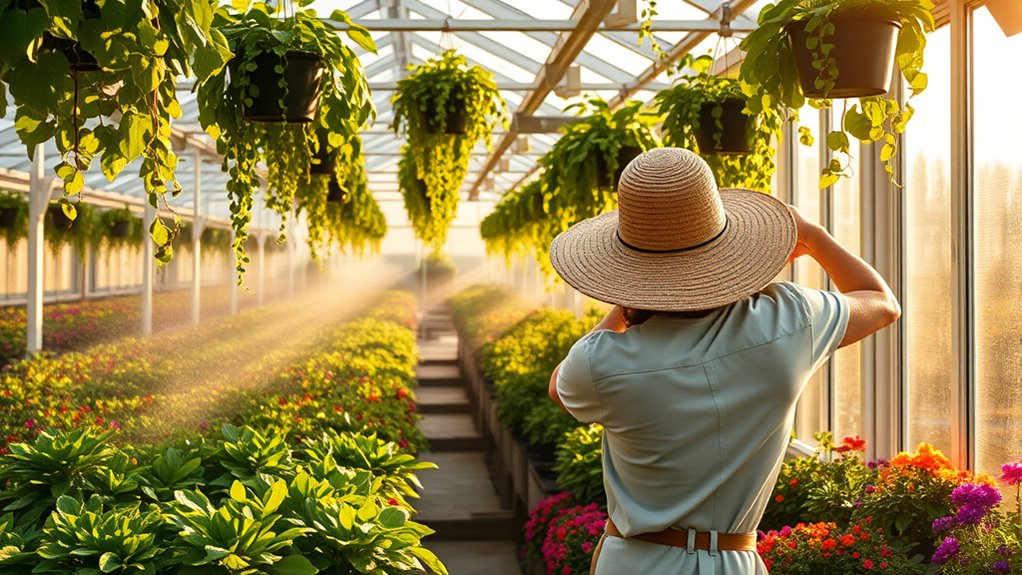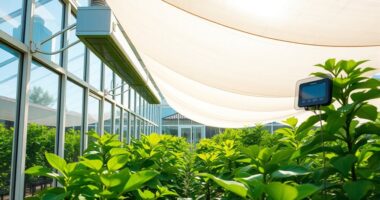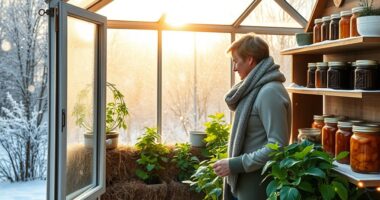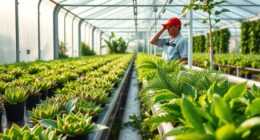To keep your greenhouse cool during summer, maximize ventilation by using roof and side vents to enhance airflow. Install evaporative cooling systems and incorporate shading methods like shade cloth or whitewash to reduce heat. Utilize plants' transpiration by selecting varieties with large leaves that provide shade. Regular maintenance, such as cleaning panels and checking irrigation, is crucial. With these strategies, your plants will thrive, and there's plenty more you can do to optimize their environment.
Key Takeaways
- Maximize ventilation by ensuring at least 20% of the greenhouse floor area is dedicated to vents for effective air exchange.
- Implement evaporative cooling systems, such as fan and pad setups, to lower temperatures during hot summer days.
- Utilize exterior shading options, like shade cloth, to reduce heat and protect plants from harmful UV rays.
- Monitor conditions with wireless sensors to optimize temperature, humidity, and air circulation for better plant health.
- Regularly maintain and clean the greenhouse to ensure optimal light penetration and prevent disease spread among plants.
Understanding Greenhouse Heat Dynamics
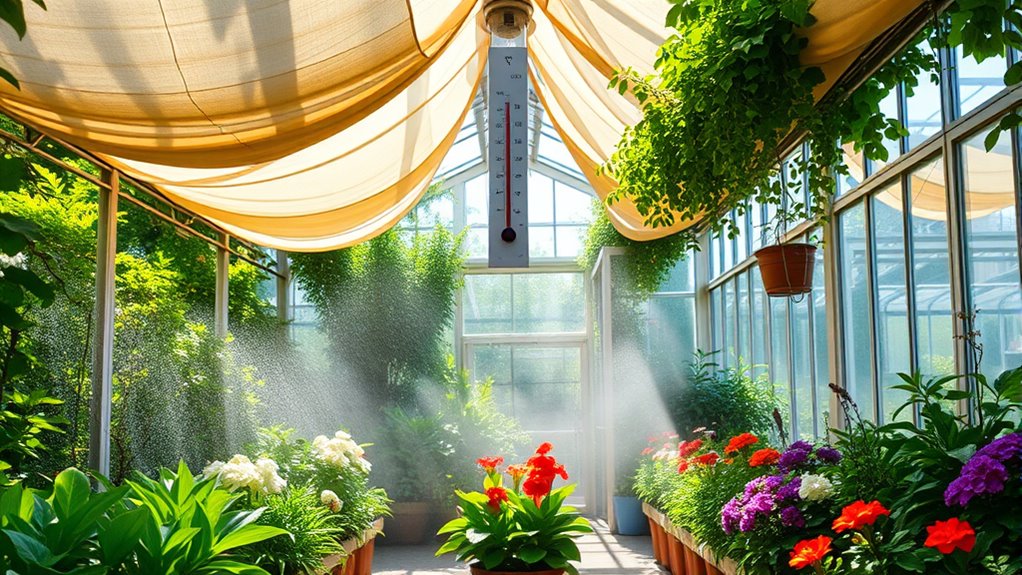
When you understand greenhouse heat dynamics, you can better manage the temperature for your plants.
Solar radiation plays a significant role, transmitting short-wave radiation that heats your greenhouse. Crop transpiration affects temperature distribution, with increased temperature variations. The soil also absorbs and emits heat, influencing the overall energy balance. Maximizing ventilation through vents and fans can significantly enhance air circulation and help regulate temperatures.
Solar radiation, crop transpiration, and soil heat dynamics collectively influence your greenhouse's temperature balance.
Air circulation is essential; it helps dissipate heat, driven by ventilation and fans. Moreover, the type of greenhouse cover you choose affects heat retention and dissipation.
To maintain an optimal environment, consider external climate factors and your greenhouse's design. Implementing shading techniques and proper watering strategies can further help control temperatures, ensuring your plants thrive even in the summer heat.
Effective Ventilation Strategies
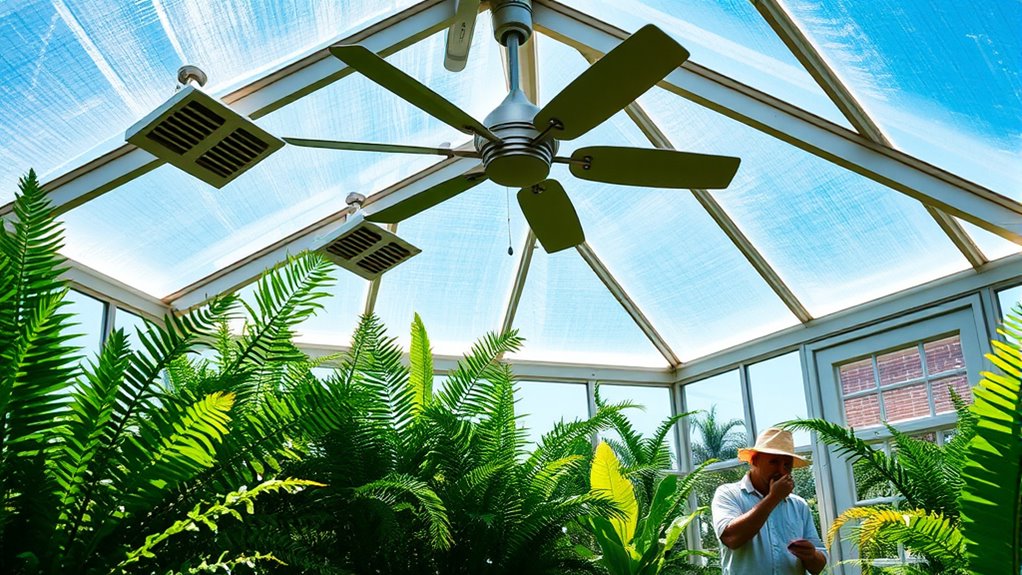
Managing temperature in your greenhouse is only part of the equation; effective ventilation strategies are key to maintaining a healthy environment for your plants.
Start with roof vents positioned at the highest points to expel hot air, while side vents draw in cooler air for balanced airflow. Aim for at least 20% of your total floor area as vent space to ensure effective air exchange. Temperature control is essential not just for comfort but also for preventing overheating and ensuring optimal plant health. Additionally, consider using portable AC units to further enhance cooling during extreme heat. Proper camping gear reviews can inform you about the best portable cooling devices for your greenhouse.
Utilize natural ventilation by opening windows and doors when conditions are right. For more control, consider automated systems with sensors that adjust vents based on temperature and humidity.
Remember to position vents considering prevailing winds and to create cross ventilation, enhancing airflow and keeping your greenhouse cool.
Implementing Evaporative Cooling Systems
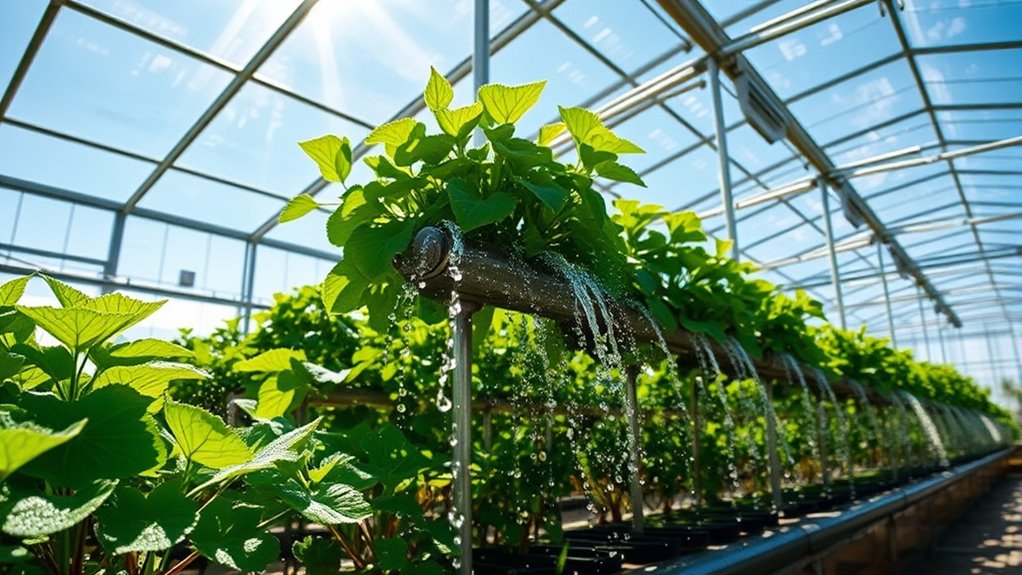
To keep your greenhouse cool during the sweltering summer months, implementing an evaporative cooling system can be a game changer. This energy-efficient method uses heat from the air to evaporate water, effectively lowering the temperature while increasing humidity—ideal for plants that thrive in moist environments. You can choose from various systems like fan and pad setups or misting systems, depending on your greenhouse size. Evaporative cooling increases humidity and decreases temperature, making it essential for maintaining a comfortable environment for your plants. Make sure to position cooling pads opposite the prevailing wind for maximum effect. Regularly check your water supply to avoid mold growth, and use thermostats to maintain optimal conditions.
Utilizing Shading and Insulation

Combining evaporative cooling systems with shading and insulation enhances your greenhouse's ability to maintain optimal temperatures during the hot summer months.
You can effectively reduce heat by implementing exterior shading options like shade cloth or whitewash. Shade cloth, available in various densities, can lower temperatures by up to 10°F while protecting your plants from harmful UV rays. Light color or aluminized materials can lower greenhouse temperatures by up to 30%, making them an excellent choice for effective cooling. Additionally, high omega-3 content in chia seeds can support plant health, which is essential during stressful heat conditions. Rich fiber content in chia seeds also contributes to the overall wellness of your plants, helping them cope with heat stress. Historically, chia seeds were utilized by ancient civilizations for their nutritional benefits, emphasizing their importance in diets.
Aluminized shade cloth reflects more sunlight, further cooling your greenhouse. Regularly inspect and securely attach your shade materials to withstand the elements.
Consider seasonal application of shading compounds to maximize light during winter. By using these shading techniques, you'll manage light levels efficiently, save energy, and ensure your plants thrive in a cooler, healthier environment.
Harnessing Plant-Based Cooling Methods

While you might rely on mechanical systems to cool your greenhouse, harnessing plant-based cooling methods can significantly enhance your climate control efforts. Plants naturally cool your space through transpiration, absorbing water and releasing vapor, which lowers temperatures. Select plants with high transpiration rates and strategically place larger leaf plants to provide shade and improve air circulation. Proper ventilation is essential to maintain temperature within optimal limits, as it allows for adequate air changes that promote a favorable environment for plant growth. Additionally, understanding plant transpiration rates can help you choose the best species for your greenhouse. Timing your irrigation for early morning or late evening maximizes evapotranspiration, while drip irrigation helps manage humidity and prevent heat buildup. Furthermore, incorporating heat-tolerant plants into your greenhouse design can enhance cooling and thrive under warmer conditions. Additionally, planting a diverse array of heat-tolerant species can create beneficial microclimates.
Leveraging Technology for Temperature Control
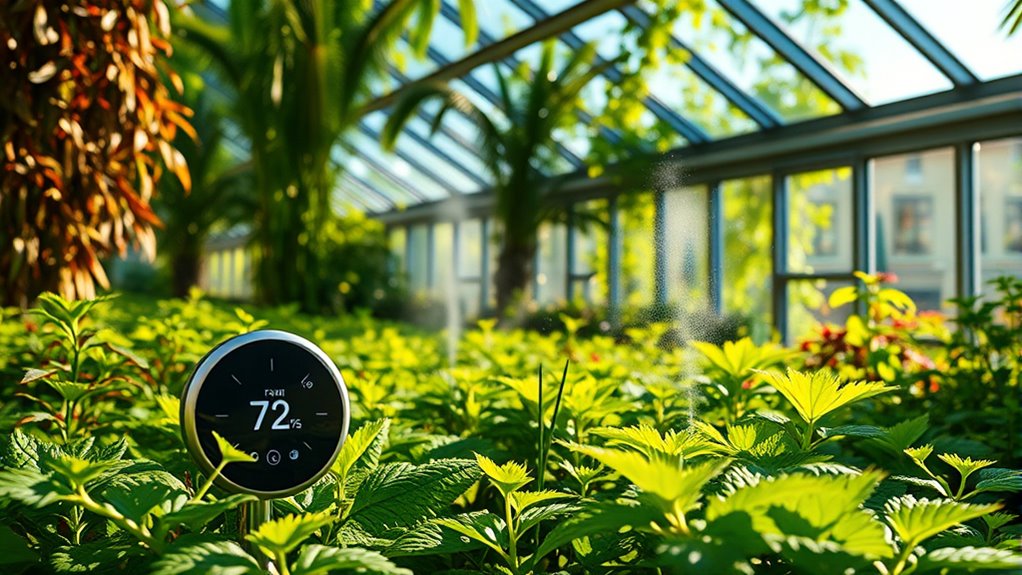
As you implement plant-based cooling methods in your greenhouse, don't overlook the power of technology for temperature control.
Advanced sensors can monitor temperature fluctuations and humidity levels, allowing you to make real-time adjustments to create optimal conditions for your plants. Additionally, forecast control can prevent sudden climate changes inside the greenhouse, ensuring a stable environment for your crops. Embracing imagination's power can also inspire innovative solutions for enhancing your greenhouse's cooling strategies. Proper maintenance practices are essential for keeping these systems functioning efficiently, as inadequate maintenance can lead to decreased efficiency and premature breakdown.
Automated climate control systems can adjust heating and cooling based on your crops' needs and external weather, ensuring energy efficiency. By integrating IoT technology, you can remotely monitor and manage conditions with wireless sensors, optimizing irrigation and temperature control.
Additionally, automated ventilation systems can enhance airflow while keeping temperatures in check. Embracing these technologies not only improves your greenhouse environment but also maximizes plant health and productivity throughout the summer. Moreover, incorporating energy-saving features can significantly reduce your operational costs while maintaining optimal conditions for growth.
Routine Maintenance for Optimal Performance
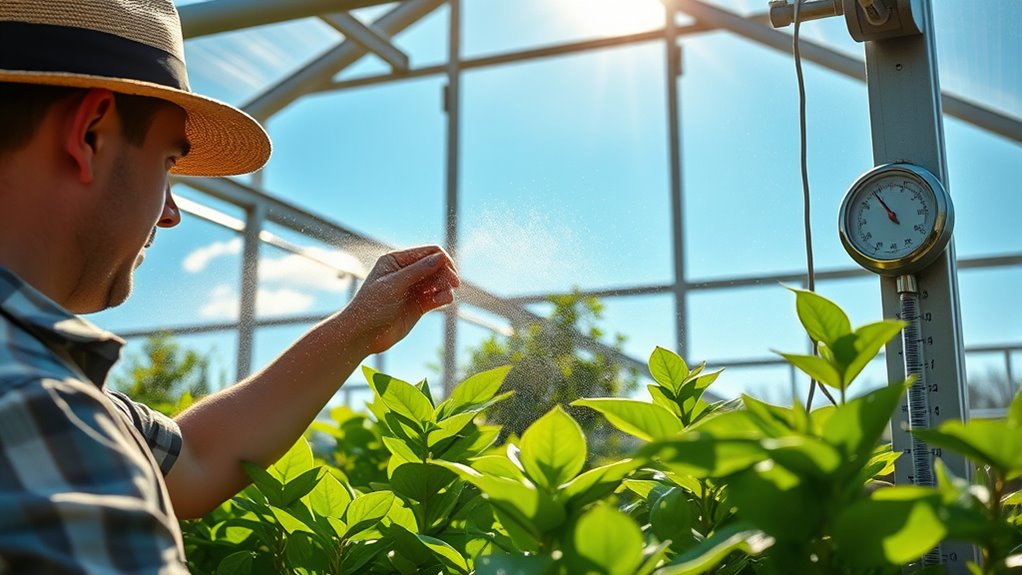
To keep your greenhouse thriving throughout the summer, regular maintenance is essential.
Start by cleaning the space thoroughly—remove debris, dead plants, and clean glass or polycarbonate panels for optimal light. Organize your tools for easy access during the busy season, and sweep the floors to prevent disease spread.
Next, inspect the structure for winter damage; replace broken vents or windows and check for rot in wooden frames. Ensure proper ventilation by opening roof and side vents, or consider installing automatic vent openers to enhance the airflow.
Regularly check your irrigation systems for leaks and water your plants early or late to maintain moisture levels.
Lastly, monitor for pests and prune plants to enhance air circulation, promoting overall health.
Frequently Asked Questions
How Can I Tell if My Greenhouse Is Too Hot?
You can tell if your greenhouse is too hot by checking the temperature, ideally between 80-85°F.
If you notice your plants wilting, drying out, or looking unhealthy, that's a sign of heat stress.
Pay attention to air circulation; if it feels stifling for you, it's likely too hot for your plants.
Additionally, high humidity can worsen the situation, so keep an eye on those levels to ensure your plants thrive.
What Plants Are Best for Summer Cooling?
For summer cooling, choose large leaf plants like colocasia or ferns, which provide shade and increase humidity through transpiration.
Heat-loving varieties, such as tomatoes, can also help regulate temperature.
Position shade providers strategically near windows and vents to block sunlight while allowing airflow.
Consider plants with broad leaves to enhance ventilation and promote evaporation.
Regular watering and pruning will keep these plants healthy and effective at cooling your space during hot summer months.
How Often Should I Check Greenhouse Temperatures?
Imagine stepping into a greenhouse where plants thrive, bathed in perfect warmth.
You should check greenhouse temperatures daily, recording the highs and lows. During extreme weather, increase your checks to ensure everything stays within safe limits.
Automated systems can handle the heavy lifting, sending alerts if things go awry. Trust reliable sensors for accuracy, and you'll create a nurturing environment for your plants, ensuring they flourish under your care.
Can I Use Fans in a Humid Environment?
Yes, you can definitely use fans in a humid environment. They help circulate air, which is crucial for maintaining a comfortable atmosphere.
While fans might feel less effective at cooling due to slower sweat evaporation, they still enhance airflow and support temperature regulation.
Opt for high CFM fans to maximize performance and consider pairing them with dehumidifiers for better results.
Regular maintenance ensures your fans operate efficiently, making them a cost-effective cooling option.
What Are Common Pests in Hot Greenhouses?
Ever wondered what pests might invade your hot greenhouse? Common culprits include aphids, spider mites, and fungus gnats.
These pests thrive in warm, humid conditions, often targeting stressed plants. Leafhoppers and caterpillars can also wreak havoc on your crops.
To keep your plants healthy, regularly scout for signs of infestation and consider using sticky traps. Integrating biological controls can help maintain a balanced ecosystem and keep those pests at bay.
Conclusion
Keeping your greenhouse cool during summer isn't just about comfort; it's vital for your plants' health. Did you know that a temperature increase of just 10°F can reduce crop yields by up to 30%? By implementing effective ventilation, shading, and cooling systems, you're not only protecting your investment but also ensuring a vibrant, thriving garden. So, take these strategies to heart, and watch your plants flourish even in the heat!
